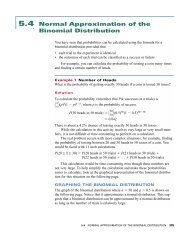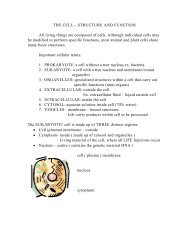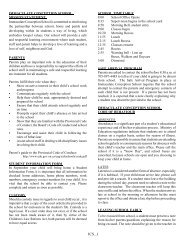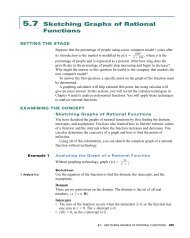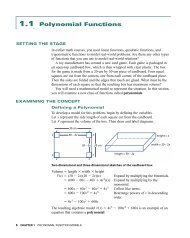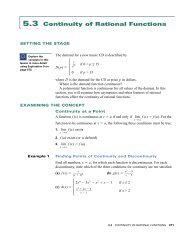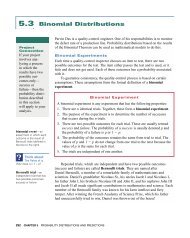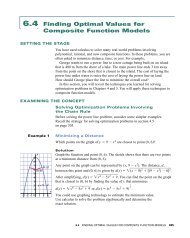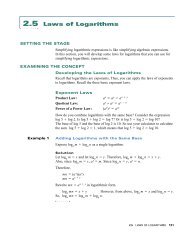Pg 247
Pg 247
Pg 247
You also want an ePaper? Increase the reach of your titles
YUMPU automatically turns print PDFs into web optimized ePapers that Google loves.
When a particle is moving<br />
along a straight line, it is a<br />
common mistake to think<br />
that the particle speeds up<br />
when the acceleration is<br />
positive and that the<br />
particle slows down when<br />
the acceleration is<br />
negative. Keep these<br />
points in mind:<br />
• Speed increases when<br />
the velocity and the<br />
acceleration have the<br />
same signs.<br />
• Speed decreases when<br />
the velocity and the<br />
acceleration have<br />
opposite signs.<br />
For example,<br />
• when a > 0, a car going<br />
forward speeds up and<br />
a car going backward<br />
slows down<br />
• when a < 0, a car going<br />
forward slows down<br />
and a car going<br />
backward speeds up<br />
a(t) v′(t) s′′(t)<br />
d d<br />
v(t) d<br />
[s(t)] <br />
t d<br />
(3t<br />
t<br />
3 40.5t 2 162t)<br />
9t 2 81t 162<br />
d<br />
d<br />
a(t) d<br />
[v(t)] <br />
t d<br />
(9t<br />
t<br />
2 81t 162)<br />
18t 81<br />
a(6) 18(6) 81<br />
27<br />
At 6 s, the velocity is increasing at the rate of 27 m/s 2 .<br />
(b) The velocity is decreasing when a(t) v′(t) < 0.<br />
18t 81 < 0<br />
18t < 81<br />
t < 4.5<br />
Since t ≥ 0, the velocity is decreasing when 0 ≤ t < 4.5.<br />
(c) The velocity is increasing when a(t) v′(t) > 0.<br />
18t 81 > 0<br />
18t > 81<br />
t > 4.5<br />
The velocity is increasing when t > 4.5.<br />
(d) The velocity is not changing when a(t) v′(t) 0. Substituting and solving<br />
as above gives t 4.5. The velocity is not changing at 4.5 s.<br />
CHECK, CONSOLIDATE, COMMUNICATE<br />
1. Explain how to determine the second derivative of a function.<br />
2. What is the relationship between the position of a moving object and its<br />
acceleration?<br />
3. The instantaneous velocity of an object is decreasing. What does this<br />
change imply about the object’s acceleration?<br />
4. The instantaneous velocity of an object is increasing. What does this<br />
change imply about the object’s acceleration?<br />
KEY IDEAS<br />
• The derivative of the derivative of a function is called the second<br />
d<br />
derivative. Symbols for the second derivative are f ′′(x), 2 y 2<br />
d x 2, d<br />
dx 2[ f (x)],<br />
or y′′.<br />
• Use the second derivative to determine the rate of change of the rate of<br />
change of a given function. The most common application of the second<br />
derivative is acceleration.<br />
250 CHAPTER 3 RATES OF CHANGE IN POLYNOMIAL FUNCTION MODELS



